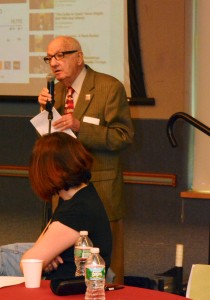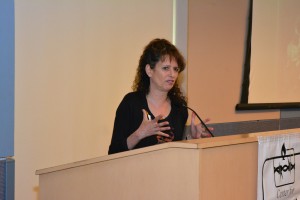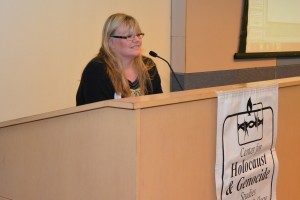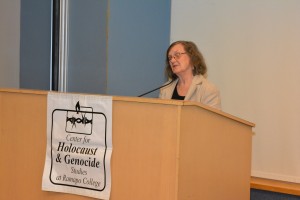- About Ramapo
- Academics
- Admissions & Aid
- Student Life
- Athletics
- Alumni
- Arts & Community
- Quick Links
- Apply
- Visit
- Give
GUMPERT TEACHERS’ WORKSHOP FOCUSES ON GENOCIDE CONVENTION AS LIVING TEXT
(PDF) (DOC) (JPG)May 29, 2014
(MAHWAH, NJ) – On May 14, 2014, the Center for Holocaust and Genocide Studies sponsored a Gumpert Teachers’ Workshop, “The U.N. Convention on Genocide as a Living Text: A Case Study for the Classroom” in conjunction with the New Jersey State Commission on Holocaust Education that also financially supported the endeavor.
Following a brief introduction by Center director Dr. Michael A. Riff who placed the topic of the day in the context of contemporary events, the State Commission’s Executive Director, Dr. Paul Winkler, presented an inspiring overview of how a close reading of the Convention on Genocide as an evolving text can be used to satisfy the State Mandate on Holocaust Education as well as several key core context standards.
Acclaimed author and scholar Dr. Donna-Lee Frieze, editor of Totally Unofficial: The Autobiography of Raphael Lemkin (Yale University Press, 2013) delivered the keynote lecture. She traced the development of the original text of the Convention as a living document; from the time Lemkin first drafted it in the late 1940s to the present day. She especially drew attention to how the Convention’s text was inevitably the product of diplomatic compromise and a particular moment in history, when the Holocaust loomed large in the consciousness of the international community. Frieze also stressed how Lemkin’s obsession with proving intent on the part of alleged perpetrators may have made bringing them to justice and achieving convictions too difficult.
Donna-Lee Frieze is a Research Fellow in the School of History, Heritage and Society at Deakin University in Victoria, Australia. She received her B.A. in Philosophy and literary studies from Deakin University in 1994 and her Ph.D. in Genocide Studies, Philosophy and Film from Deakin University in 2006.
Dr. Frieze received the Australian Postgraduate Scholarship in 2003, the Naomi and Isi Leibler prize for the best M.A. or Ph.D. thesis approved during 2005 in the area of social sciences at Deakin University in 2006 and the Myer Burston Scholarship at the Jewish Holocaust and Research Centre in Melbourne in 2008. Currently, Dr. Frieze is the Prins Foundation Senior Scholar at the Center for Jewish History in New York City.
Jill McCracken, a teacher of Social Studies at Holmdel High School and an instructor at the Holocaust, Genocide and Human Rights Center of Brookdale Community College in Lincroft, New Jersey, delivered a presentation on how to bring the study of the evolution of the Genocide Convention into the classroom. Echoing the remarks of Dr, Fireze, she discussed her lesson plan the title of which embodied the crucial question of the day: “How well does the U.N. Genocide Convention function in the 21st Century?”
Ms. McCracken holds a B.A. from the College of New Jersey and an M.A. from Norwich University in Vermont. She has been a member of the Board of Directors of the Holocaust, Genocide, and Human Rights Education Center at Brookdale Community College for more than 30 years.
In 2000, on her way home from studying at Yad Vashem, Israel on a special scholarship, McCracken visited Kosovo, which earlier had experienced ethnic cleansing and a NATO war with Serbia. She managed to get herself embedded with the Army’s 326th Mobile Public Affairs Detachment. It was a unique experience for a teacher, and led her to work in the region, reconciling Albanian and Serbian students in the newly independent Republic of Kosova. From 2001-2009, she also worked with the Organization for Security and Cooperation in Europe (OSCE) evaluating the quality of election in nations developing democracy and democratic institutions, serving in Croatia, Azerbaijan, Kyrgyzstan, and Ukraine.
Concluding the program was Nancy Steinson Ehrlich who reflected on her friendship with Raphael Lemkin A native of Louisville, Kentucky, she came to New York in 1957 after completing her undergraduate training in Political Science at the University of Louisville. While there, she was instrumental in the establishment of a meeting space for foreign and American students, so it was not surprising that the head of the University’s foreign student office recommended her for a position at New York’s International House, which enabled her to pursue her dual interests in political science and the arts. As she explained, being at International House on Riverside Drive led to her first encounter in 1958 with Raphael Lemkin, after which she became his close friend and assisted him in the preparation of his autobiography.
Steinson Ehrlich is a sculptor, who, apart from her works in paper, makes geometric shapes in welded steel and bronze. She holds an M.A. in Art Education from Columbia University Teachers College.
Attended by 60 educators from throughout New Jersey, each of the workshop’s presentations was accompanied by an unusually lively Q&A.
E-News Archives
| 2023 | 2022 | 2021 | 2019 | 2018 | 2017 | 2016 | 2015 | 2014 | 2013 | 2012 | 2011 | 2010 | 2009 | 2008 | 2007 |Copyright ©2025 Ramapo College Of New Jersey. Statements And Policies. Contact Webmaster.





Follow Us!